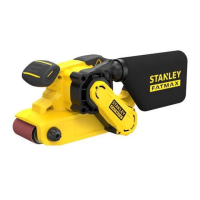4
ENGLISH
(Original instructions)
u Do not let children or pregnant women enter the
work area.
u Do not eat, drink or smoke in the work area.
u Dispose of dust particles and any other debris
safely.
u The intended use is described in this instruction manual.
The use of any accessory or attachment or performance
of any operation with this tool other than those recom-
mended in this instruction manual may present a risk of
personalinjuryand/ordamagetoproperty.
Safety of others
u This appliance is not intended for use by persons (includ-
ing children) with reduced physical, sensory or mental
capabilities, or lack of experience and knowledge, unless
they have been given supervision or instruction concern-
ing use of the appliance by a person responsible for their
safety.
u Children should be supervised to ensure that they do not
play with the appliance.
Residual risks.
Additional residual risks may arise when using the tool which
may not be included in the enclosed safety warnings. These
risks can arise from misuse, prolonged use etc.
Even with the application of the relevant safety regulations
and the implementation of safety devices, certain residual
risks can not be avoided. These include:
u Injuriescausedbytouchinganyrotating/movingparts.
u Injuriescausedwhenchanginganyparts,bladesorac-
cessories.
u Injuriescausedbyprolongeduseofatool.Whenusing
any tool for prolonged periods ensure you take regular
breaks.
u Impairment of hearing.
u Health hazards caused by breathing dust developed when
using your tool (example:- working with wood, especially
oak, beech and MDF.)
Vibration
The declared vibration emission values stated in the technical
data and the declaration of conformity have been measured
in accordance with a standard test method provided by
EN 62841 and may be used for comparing one tool with
another. The declared vibration emission value may also be
used in a preliminary assessment of exposure.
Warning! The vibration emission value during actual use of
the power tool can differ from the declared value depending
on the ways in which the tool is used. The vibration level may
increase above the level stated.
When assessing vibration exposure to determine safety
measuresrequiredby2002/44/ECtoprotectpersonsregularly
using power tools in employment, an estimation of vibration
exposure should consider, the actual conditions of use and the
way the tool is used, including taking account of all parts of the
operating cycle such as the times when the tool is switched off
and when it is running idle in addition to the trigger time.
Labels on tool
The following pictograms are shown on the tool along with the
date code:
:
Warning! Toreducetheriskofinjury,theuser
must read the instruction manual.
Electrical safety
#
This tool is double insulated; therefore no earth wire
is required. Always check that the power supply
corresponds to the voltage on the rating plate.
u If the replacement of the supply cord is necessary, this
has to be done by the manufacturer or authorised Stanley
FatMax Service Centre in order to avoid a safety hazard.
Features
This tool includes some or all of the following features.
1.On/offswitch
2. Lock-on button
3. Variable speed dial
4. Handle
5. Tension lever
6. Centring knob
7. Dust extraction outlet
Assembly
Warning! Before assembly, make sure that the tool is
switched off and unplugged.
Fitting a sanding belt (g. A)
Warning! Never use the tool without a sanding belt.
u Pull the tension lever (5) outward to release the tension on
the sanding belt (9).
u Remove the old sanding belt.
u Place a new sanding belt over the rollers. Ensure that the
arrow on the sanding belt points in the same direction as
the arrow on the tool.
u Push the tension lever (5) inward to tension the sanding
belt.
Adjusting the sanding belt tracking (g. B)
To ensure a correct tracking, the sanding belt must be centred
over the rollers.

